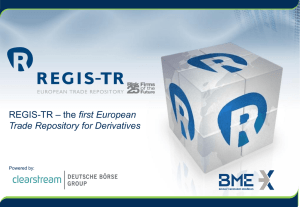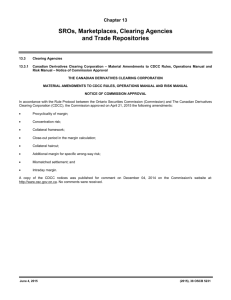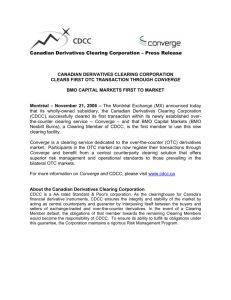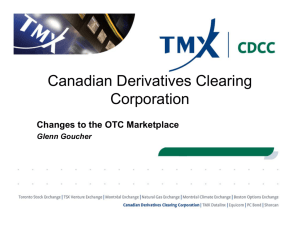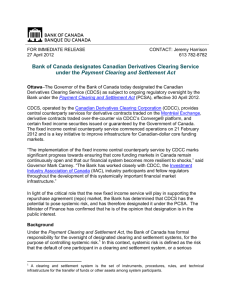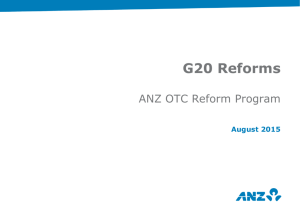Document
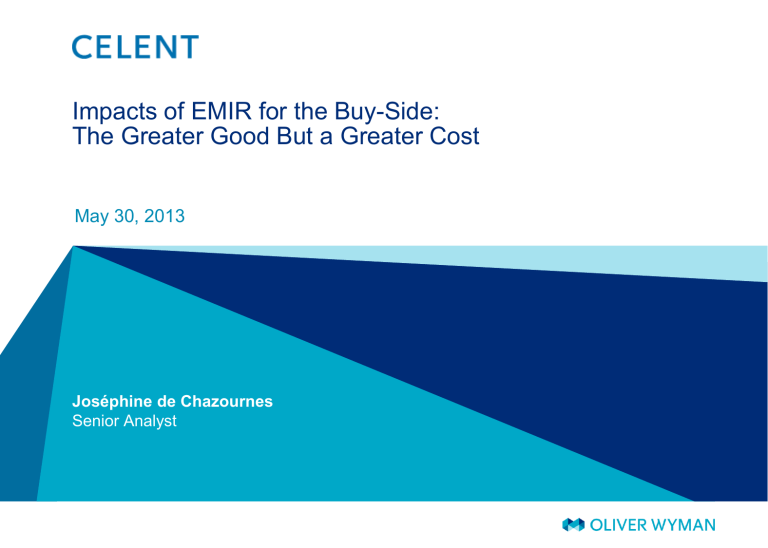
Impacts of EMIR for the Buy-Side:
The Greater Good But a Greater Cost
May 30, 2013
Joséphine de Chazournes
Senior Analyst
A recording of today's webinar and copy of the presentation will be available to Celent clients on our website at http://celent.com/user/login
© Oliver Wyman
Introduction
• In the EMIR report that inspired this Webinar, we drew upon some of the findings of a global survey commissioned by Omgeo and executed independently by Celent during
1Q2013.
• The aim of the survey was to better understand the impacts that the many regulations, being discussed and implemented at the moment, are having on the buy side.
• We specifically surveyed only buy-sides that use derivatives. All of the surveyed use derivatives for hedging, about 66% use them for asset/liability management, and respectively 33% and 28% of them use derivatives for speculation and active alpha generation.
•
90% of the buy sides surveyed believe that aggressive regulatory changes and uncertainties are putting the most pressure on their businesses in 2013 .
• Not surprisingly, EMIR, DFA, and Basel III are expected to exert the largest influence on the economics of the trading of derivatives in the next two years.
© Oliver Wyman
Agenda for today
Regulatory Framework
Direct Impacts for the Buy Side
Outstanding Questions
© Oliver Wyman
© Oliver Wyman
1
Regulatory Framework
Background on EMIR
• The G20 September 2009 communiqué: standardized over-the-counter (OTC) derivative contracts to be cleared through central counterparties by the end of 2012.
• In the US, the reform has taken the shape of the Dodd-Frank Act (DFA).
• In Europe, a number of different pieces of legislation or directives tackle this: EMIR looks mainly at regulating derivatives, central counterparties (CCPs), and trade repositories.
• Unlike DFA, EMIR does not address trading, which will fall under the MiFID2 reform
• EMIR introduces requirements to
• Improve transparency and reduce risks associated with the derivatives market,
• Establish common organizational, conduct of business, and prudential standards for CCPs and trade repositories.
• All types and sizes of entities that enter into any derivative contract, including NFC.
• It applies indirectly to non-EU firms trading with EU firms.
• Our latest estimates do not forecast the mandatory clearing of derivatives in Europe before 1Q2015.
© Oliver Wyman
EMIR Key Requirements
• EMIR requires entities that trade any derivative contract to:
• Report every derivative contract that they enter to a trade repository;
• Implement new risk management standards, including operational processes and margining, for all bilateral OTC derivatives.
• The clearing obligation requested by EMIR, via a CCP, is only for a subset of OTC derivatives and excludes so far:
• Forward foreign exchange instruments unless caught by scope of the Regulated
Activities Order (RAO)
• A nondeliverable currency forward that is not a “future” for the purposes of the
RAO because it is made for commercial purposes
• Spot transactions in both foreign exchange and commodities
© Oliver Wyman
EMIR timeline as of May 22
nd
2013
• B: CCPs to apply for authorization [At ; A+6 months]
• C: NCA to authorize
CCPs [B+1 month ;
B+6 months]
EMIR entered into force
16 August
Commission Delegated
Regulations supplementing EMIR
19 December
Initial notification of OTC derivatives under Article
89(5)* for preparatory work for the clearing obligation [A+ 1 month]
15 April 15 September
• Notification for the clearing obligation under Art.5
[immediately after C]
• ESMA to submit draft RTS on the clearing obligation
[C+ 6 months]
15 March 16 September
2012 2013
27 September
ESMA published draft technical standards
23 February 15 March
Publication of
Delegated
Regulations in the
EU Official Journal
A: Entry into force of technical standards
1 August
E: Possible
Registration of a
TR [D+ 60 working days**
+ 5 working days***]
Possible
Reporting start date (IR and credit derivatives) if a
TR is registered for that asset class [E+ 90 calendar days
Possible
Reporting start date (all other asset classes) if a TR is registered for these asset classes before
1 October 2013
D: TR to start sending application to ESMA [=A]
30 October 1 January
2014
Legend:
CCP authorization process
OTC clearing obligation process
TR obligation process
Recent legislative process
Notes: * the notification under EMIR article 89(5) will not trigger the front-loading period for a class of derivatives as described in EMIR article 4(1)(b)(ii). This front-loading period will only be initiated by the notification referred to in EMIR article 5(1).
** the exact duration of the registration process of a TR will depend on whether the application is complete when it is filed and whether additional information has to be submitted to ESMA
***the registration decision takes effect on the fifth working day following its adoption
© Oliver Wyman
Reporting Requirements
• All counterparties with outstanding derivative contracts must report, post-trade, details of those contracts, and any new contracts they enter into, to an authorized TR.
• All counterparties to all derivatives contracts (all OTC and exchange-traded transactions in the EEA) need to report contract details to a registered TR. This includes intragroup trades and trades with NFCs.
• Information to be reported to TRs
• The parties to the contract (or the beneficiary)
• Type of contract
• Maturity
• Notional value
• Price
• Settlement date
• FCs and NFCs above the clearing threshold are required to report exposures to monitor systemic risk. They need to report mark-to-market or model valuations and collateral value and basis.
• How to Report?
• Both counterparties must report each trade unless one party can report on behalf of both counterparties.
• The reporting party may be the counterparty to the trade, or a third party.
© Oliver Wyman
Reporting Timeline
• After the draft RTS came into force, TRs could start sending their applications to ESMA.
• It is believed that up to eight TRs intend to apply.
• ESMA then has up to two months to authorize and register a TR. Reporting start dates for certain asset classes, which are highlighted below, are only applicable if a TR has been registered for this asset class.
Timeline for EMIR Reporting Requirements to Trade Repository
TIMELINE FOR
REPORTING
If a TR is registered if no TR is registered
CREDIT AND
INTEREST RATES
DERIVATIVES
By April 1, then:
ALL OTHER
DERIVATIVES
By October 1, then:
Begins 1 July 2013
By April 1, then:
Begins 1 January
2014
By October 1, then:
90 days after registration
90 days after registration
90 days to report to TR BACKLOADING
EXISTING
TRADES
If outstanding at time of reporting date
Source : FSA, Celent
If not outstanding but remained outstanding on 16
August 2012
3 years to report to TR
© Oliver Wyman
Clearing Requirements
• OTC derivatives contracts that ESMA has determined to be subject to a mandatory clearing obligation must be cleared by a CCP.
• Bottom-up process : ESMA decides whether contracts already cleared by a CCP need mandatory clearing according to its standardizability and liquidity. If mandatory clearing is enforced, all newly executed contracts of the determined type must be cleared.
• ESMA has begun the bottom-up approach part of assessing contracts in 2Q2013
•
Frontloading : After
ESMA’s bottom-up process begins, but before mandatory clearing takes effect, products must also be cleared.
•
The
“top down” approach
: ESMA will then determine which products need mandatory clearing, product by product and on an ongoing basis.
• The first clearing obligations are likely to be in 1Q2015.
• For FCs, contracts not cleared through a CCP will also be subject to bilateral collateral requirements.
• CCPs started applying for authorization with ESMA to clear under EMIR after the regulatory technical standards (RTS) entered into force on 15 th March 2013. The NCA has up to six months to review and approve the CCP application and authorize the CCP.
• Rumors are that up to 25 CCPs (EU as well as non-EU) might apply.
• Draft RTS on Initial Margin require CCPs to set confidence levels for the calculation of initial margin at least at 99.5% (OTC derivatives) and 99% exchange-traded derivatives).
However, for OTC derivatives that share the same risk characteristics as exchange-traded derivatives, the CCP may lower the confidence level for the noncleared derivatives to
99%.
© Oliver Wyman
Other EMIR Requirements
• All uncleared OTC derivative trades request require timely confirmation, dispute resolution, reconciliation, and portfolio compression . The last three requirements enter into force six months after adoption of RTS.
• There are additional requirements for counterparties subject to the clearing obligation: initial and variation margin requirements and daily valuation requirements .
• FCs and NFCs above the threshold have to comply with the confirmation requirements laid out in the below table.
FINAL
CONFIRMATION
DERIVATIVE TYPE DEADLINE
CREDIT AND INTEREST RATE T+1
ALL OTHERS T+1
Source : FSA, Celent
PHASING
UNTIL
AUGUST 2013
T+2
T+3
PHASING
UNTIL
AUGUST 2014
T+2
T+2
• The below table highlights the various timeframes for portfolio reconciliation according to the number of outstanding OTC contracts that FCs and NFCs above threshold hold.
THRESHOLDS
ABOVE 500 OUTSTANDING OTC CONTRACTS
FROM 51 TO 499 OUTSTANDING OTC CONTRACTS
BELOW 50 OUTSTANDING OTC CONTRACTS
Source : FSA, Celent
TIMEFRAME FOR PORTFOLIO RECONCILIATION
Every business day
Once per week
Once per month
© Oliver Wyman
EMIR Exemptions
• Clearing exemptions for intragroup transactions when:
• The EU Commission has recognized equivalent requirements in a non-EU country
• The trades are subject to the same consolidation on a full basis
• There are appropriate centralized risk evaluation, measurement, and control procedures in place
•
Margin exemptions for uncleared trades of intragroup transactions when:
• The risk management procedures of the counterparties are adequately sound, robust, and consistent with the complexity of the derivatives contract.
• There are no practical or legal impediments to the prompt transfer of funds or repayment of liabilities between counterparties.
• Pension fund exemption from central clearing until August 2015
• In the meantime, the regulators are making efforts to develop a technical solution for the transfer of non-cash collateral as variation margin to CCPs.
• European pension funds will still have to abide by the risk management and reporting obligations when they take effect.
• Pension funds may decide to start clearing before it becomes compulsory for them because other regulatory or capital requirements make the cost of noncleared derivatives transactions too high.
© Oliver Wyman
Main Differences with Dodd Frank
• Reporting requirements :
• Only one counterparty has to report in DFA, but each counterparty has to report its own counterparty data under EMIR.
• EMIR requires reporting of all listed and OTC derivatives trades, whereas DFA requires only reporting of OTC derivatives.
• DFA requires real time reporting, whereas EMIR just requires end-of-day and historical data reporting.
•
Mandatory clearing under DFA started on March 11, 2013
• First deadline set by the CFTC for certain CDS and IRS to be mandatorily cleared by the “category 1” participants
• On June 10, there is a clearing deadline for smaller and less active “category 2” counterparties, with a final deadline of September 9 for the rest of the market.
• DFA Impartial Access to Swap Execution Facilities (SEFs)
• Each SEF’s rule book will target certain clients rather than others
• Some big buy-side firms will decide to start trading directly or providing liquidity directly to these new venues
• How will MiFID2 regulate trading venues?
• The interdealer broker (IDB) and dealer-to-client (D2C) business models of fixed income and FX products are converging towards models that include access to the buy side, a trend that leans in the same direction as the impartial access rule
© Oliver Wyman
© Oliver Wyman
2
Direct Impacts for the Buy Side
Major Buy Side Priorities for Clearing Operations/Technology in Next 12
Months
Other (please specify) 5%
Elimination of duplicate / overlapping IT systems 0%
Defining what products will be financially interesting to keep doing e.g. Bilaterallly vs. Cleared OTC vs. traded and cleared
Data management and quality – both governance and consistency of golden source systems around clearing workflows
Upgrade clearing and operations risk management technology infrastructure for higher performance, scalability and real-time capabilities
Achieve an aggregated, firm-wide view of clearing and settlement
(in near-real time or real-time) across various markets
Improve effectiveness and efficiency of processes to incorporate new products eligible for central clearing
Address workflows around collateral disputes, exceptions and reconciliation activities
Increase straight through processing of trades from front to back office (post-trade processing)
Expand connections and relationships with more clearing providers
0%
15%
20%
20%
20%
10%
15%
20%
Source : Celent Buy Side Survey
© Oliver Wyman
30%
30%
30% 40%
45%
50%
EMIR Reporting Requirements Impacts for the Buy Side
• TR are currently organized per asset class, such as ICE Trade Vault for commodities, but some are for multiple asset classes such as DTCC and Regis-TR. Many new TRs are expected to be set up.
• The important issues for the buy side are:
• Which TRs can you report to for the types of derivatives you trade?
• Will you report directly to the TR or delegate reporting to your counterparty, or to a third party?
• We believe that tier 1 buy sides will report themselves to the TR, but that tier 2 and 3 buy sides will delegate their brokers or banks to do it for them.
© Oliver Wyman
EMIR Clearing Requirements Impacts for the Buy Side
• Which CCP clears the types of OTC derivatives they trade?
• Some CCPs will focus on a specific asset class, while others will propose an all-asset offering.
• The buy side will have to choose not only where to trade but also where to clear the derivative pre-trade as various clearing houses may offer to clear a certain number of common products:
• This is to prevent traders from having a short or long position at a clearing house and to optimize the netting capabilities.
• Maybe D2C models or the liquidity aggregator SD2C platforms will be able to put the clearing options, costs, margining, netting, etc. into their models to be able to tell the buy side where it will be better to clear pre-trade.
• Direct Clearing Membership?
• Will the buy side access clearing directly as a “clearing member,” or indirectly as a client of a clearing member.
• We foresee that only a limited number of Tier1 buy sides will become clearing members, depending on the asset class. We see this as dependent on the trading pattern that the buy side will opt for.
• In assets such as equity derivatives where some funds have been direct trading members of exchanges for some time, it may make sense for them to also become direct trading members of the OTC equity derivatives platforms (if they are not so already) and potentially also clearing members.
© Oliver Wyman
IRS Buy Side Clearing: Focus on SwapClear (LCH.Clearnet)
• SwapClear clears more than 50% of all OTC interest rate swaps and more than 95% of the overall cleared OTC interest rate swap market.
• SwapClear keeps increasing its record of cleared volumes of interest rate derivatives for buy side clients. In May 2013 it recorded more than $36 trillion in notional cleared for clients as can be seen on the figure below, and category 2 clients deadline is still upcoming
Source : SwapClear
• Last summer LCH acquired the US-based International Derivatives Clearing Group
(IDCG), allowing the clearing house to clear clients’ swap transactions through a US entity for the first time, offering greater protection to local customers in the event of bankruptcy.
© Oliver Wyman
Operational Buy Side Readiness for OTC Clearing and Collateralisation
• In our survey nearly 30% of buy side players claimed they were fully operational in terms of implementation efforts for OTC clearing and collateralization.
• Overall 52% of buy side are either already live or actively testing clearing and/or collateral management suppliers, which corroborates the volumes that have been seen at the clearing houses so far.
Early planning and assessment these areas
Not started 5%
5%
5%
Not working on
Engaged in implementation
9%
Fully operational – cleared OTC trades in a live environment
28%
Actively selecting clearing and/or collateral management
24%
Source : Celent Buy Side Survey
© Oliver Wyman
Lagging
Testing cleared
OTC trades
24%
Leading
Need to Mitigate Counterparty Risk
• Most Buy Side have engaged with two to three clearing houses or clearing brokers.
• They trade a variety of securities that may need to be cleared: they may need various clearers to serve these needs.
• They are also hedging their credit risk bets in the post-Lehman era:
– They cannot afford to have just one clearer like prime brokers for hedge funds,
– They need to set up these relationships from day 1 to pre-empt operational risk in case of a default.
© Oliver Wyman
More Efficient Margining Processes
• More than 50% of respondents consider that improving the efficiency of collateral management and margining processes are the most significant changes.
• The majority of buy side firms already make daily margin calls.
• Systems already used for daily margining by these players are, however, not flexible enough to cater to the new margining requirements.
• For the remaining buy sides, this is an area which is probably handled in a very manual way but will mostly need efficiencies through systems and technology investments.
• Celent estimates the volume of margin calls will increase in coming years by 100–200%.
• For cleared markets this increase will be driven by:
• Increased activity in cleared markets with more client participation and more instruments made available
• Central clearing requiring more firms to clear and in a more efficient way
• Lack of interoperability between CCPs (in the short term?)
© Oliver Wyman
Increased Cost of Clearing
• The cost of clearing would increase by 10–20% over the next 15 months according to our survey:
Decrease >80% 0,0%
Decrease 61-80%
Decrease 41-60%
Decrease 21-40%
Decrease 10-20%
Decrease by up to 10%
Increase >80%
Increase 61-80%
Increase 41-60%
Increase 21-40%
Increase 10-20%
Increase by up to 10%
Stay the same
0,0%
0,0%
0,0%
0,0%
0,0%
0,0%
5,0%
10,0%
10,0%
10,0%
30,0%
35,0%
Source : Celent Buy Side Survey
• To evaluate cost scenarios and operational implications, the buy sides put their whole trading books and investments through the clearing house models.
• Most buy side clients operate in a multiasset class environment for exchange traded,
OTC-cleared, and noncleared derivatives.
Clearable securities have to be looked at in a clearing efficiency context taking into account the internal efficiencies that may have been lost because some securities have been segregated.
© Oliver Wyman
Segregation of Accounts and Client Sub-Pools
•
In EMIR, segregation of accounts at the clearing house is not mandatory, as opposed to DFA.
•
The main issue is around general pool vs. sub-pool asset recovery.
• In case of counterparty failure: who has priority? Would it end up being something along the lines of retail vs. institutional assets, or small vs. bigger firms
• Considering that the end client of institutional funds is also retail, if payments are to be claim-based as opposed to contribution-based, would clients be treated in a fair manner?
• One issue is around the discrimination that the segregation of accounts can imply when returning client money.
• Some investors prefer sub-pools as they would provide the opportunity to return just the money of the short-term investors and keep the long term invested - in a general pool all moneys have to be returned together.
•
The different insolvency rules in different EU member states make these discussions even more complicated.
•
Client general pooling vs. sub-pools at asset managers?
• The European CCPs are working on providing flexibility around these issues
© Oliver Wyman
EMIR Collateral Requirements Impacts for the Buy Side
• The buy side needs to ask whether they have collateral agreements in place and sufficient collateral available to collateralize non-cleared OTC derivative trades.
• They then need to have robust portfolio reconciliation tools.
• Cos of Collateral:
• Buy sides surveyed expect the cost of collateralization to increase by 10–20%.
• The savings that buy side players hope to reap from portfolio margining and netting across various cleared products are estimated to be around 10 –30%
• Net net, the actual collateral cost will be zeroed out by the savings in margining and netting of products.
• At clearing houses that have clearing solutions across various nettable products (e.g., govies, repo, and IRS), portfolio margining will be offered across assets.
• Most buy sides will move from an in-house to a third party or outsourced solution to maximize the efficiency of collateral deployment and help to improve the counterparty risk management process.
• Buy sides surveyed estimate the nature of collateral management and margining will become increasingly automated and less operationally complex in the coming years.
• One of the main priorities in 2013 is to align and enhance front office analytics and reporting capabilities to incorporate considerations around collateral and be able to concentrate the bifurcated exposure and operational effort across different venues.
© Oliver Wyman
EMIR Risk Management Impacts for the Buy Side
• The buy side needs to think about its existing systems and processes and their adequacy to implement the new operational risk mitigation requirements set out in EMIR.
• Because there will be less bilateral negotiation and less counterparty risk evaluation, there will be less staff required in risk management but more staff on derivatives margining/middle office and collateral optimization.
• For the Tier 2 and 3 buy sides, it may make sense to outsource some of the cross-asset valuation and margining to clearing brokers or clearing houses that try to differentiate themselves through these kinds of added-value products.
• The Tier 1 players typically will keep developing these in-house but also may sparingly buy a vendor solution when they need a product today and do not have resources to build it.
© Oliver Wyman
© Oliver Wyman
3
Outstanding Questions
EMIR in the Uncertain Regulatory Puzzle
• The EMIR uncertainty
– EMIR RTS are yet to be finalized.
– EMIR keeps being delayed providing more regulatory uncertainty triggering yet another incremental cost, to be borne by the end investor.
• The Cross-Border uncertainty
– EMIR and DFA are similar but different, not just because EMIR considers all OTC derivatives and DFA just swaps, or because EMIR applies to Europe and DFA to the US, or because they are not being implemented at the same time.
– The CFTC may regulate trades that are done between US and non-US players.
– The Asian market may also be regulated to some extent.
• The Adjacent Regulations uncertainty
– In Europe MiFID2/MiFIR and CRD IV will deliver more regulation for derivatives
– Market players also have to take into account these European regulations when defining their strategy – but they are not final yet either
• The Over Regulation uncertainty
– Too much regulation may hurt the competitiveness of the European markets.
© Oliver Wyman
Increased Catalogue of Products
• In our survey, 55% of buy sides estimated that their trading, investment strategies, and asset allocations will change as a result of the implementation of OTC central clearing, and 15% of them were unsure of that.
• Will the buy sides have to change the way they do business?
• We do not expect IRS to dry out and futures to pick up all that liquidity or all the bilateral trading to disappear. However, we believe that, if all of the asset classes keep coexisting, some may become more interesting from a regulatory and/or cost and/or liquidity standpoint.
• It is a change in market structure: OTC is dealer to customer bilateral; futures are an allto-all market. It is also a disintermediation of the banks.
• Futures on swaps are going to be more standard than a swap, so they are not going to replicate the hedging strategy that is desirable for certain client trades. However, for some others, the additional risk vs. margin cost trade-off will be in favor of the future.
• For the buy side, futures notably are more transparent and make middle and back office easier to manage.
• Obviously liquidity will not move to new products if the most important providers are not convinced they should do so.
• If the regulatory push for transparency keeps its course and the final versions of EMIR and
MiFIR are strong enough and the CFTC’s firm intention to keep VaR requirements remain, we see the futurization of swaps as a valid alternative to cleared swaps for the more standard strategies.
© Oliver Wyman
Open Access Requirement and Direct Clearing
• The European Commission must introduce explicit and detailed open access requirements in EMIR and MiFID2 in due course. Clearing houses must access instruments for clearing regardless of the venue on which they are traded, and a venue must provide data feeds and assistance to any clearing house that wants to clear these instruments.
• Because EMIR and MiFID2 are not implemented at the same time, the clearing landscape is being reorganized before MiFID2 comes into play, and the delay favors incumbent clearers and therefore impacts competition and costs for the buy side.
• As mentioned previously, the SEF impartial access rule and the European equivalent trading platforms for OTC-cleared derivatives will provide opportunities for the buy side to connect directly to the trading platforms.
• This means a strategic decision from the buy side’s stand point to go direct or in
“sponsored access” or “controlled direct access” in the various asset classes.
• Heavy investments are needed to make this happen:
• In trading skills via former sell side principal traders or market makers to be able to provide liquidity to the markets. This is already taking place,
• In operational, middle, and back office systems that traders need to work with.
That would include OMS or EMS systems that are able to support swaps and futures across asset classes, risk management tools, and connectivity to SEFs and OTFs/MTFs, and to the clearing houses. This takes more time to achieve.
© Oliver Wyman
QUALIFICATIONS,
ASSUMPTIONS AND LIMITING
CONDITIONS
This presentation is for the exclusive use of the client named herein. This presentation is not intended for general circulation or publication, nor is it to be reproduced, quoted or distributed for any purpose without the prior written permission of . There are no third party beneficiaries with respect to this presentation, and does not accept any liability to any third party.
Information furnished by others, upon which all or portions of this presentation are based, is believed to be reliable but has not been independently verified, unless otherwise expressly indicated. Public information and industry and statistical data are from sources we deem to be reliable; however, we make no representation as to the accuracy or completeness of such information.
The findings contained in this presentation may contain predictions based on current data and historical trends. Any such predictions are subject to inherent risks and uncertainties. accepts no responsibility for actual results or future events.
The opinions expressed in this presentation are valid only for the purpose stated herein and as of the date of this presentation.
No obligation is assumed to revise this presentation to reflect changes, events or conditions, which occur subsequent to the date hereof.
All decisions in connection with the implementation or use of advice or recommendations contained in this presentation are the sole responsibility of the client. This does not represent investment advice nor does it provide an opinion regarding the fairness of any transaction to any and all parties.
Thank you
• If you have any follow-up questions about the presentation or future studies, please contact
Andrew Renzella at arenzella@celent.com
or
Joséphine de Chazournes at jdechazournes@celent.com
• A recording of today's webinar and a copy of the presentation will be available to Celent clients on our website at http://celent.com/user/login
© Oliver Wyman
